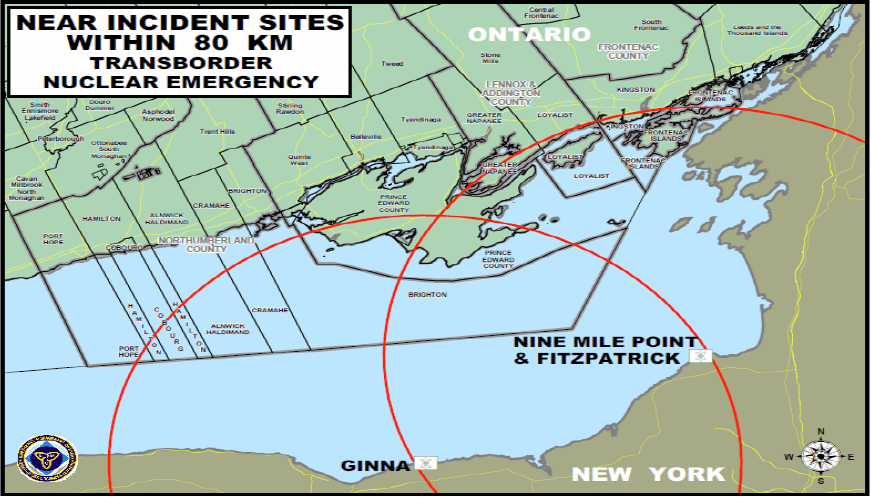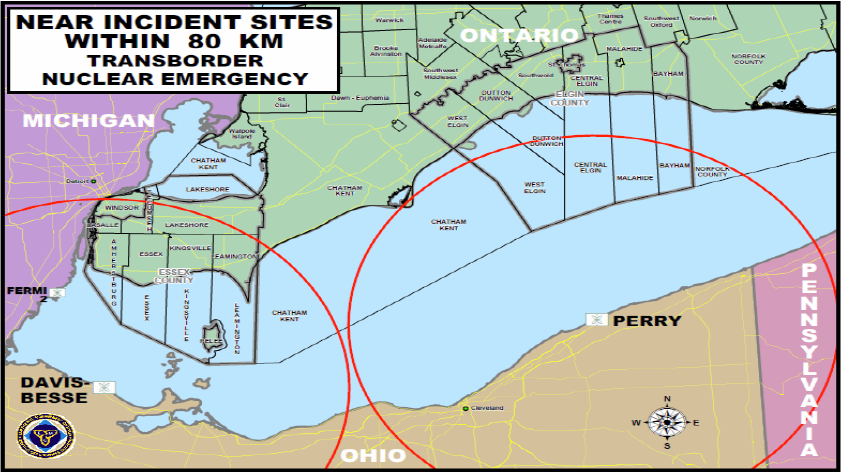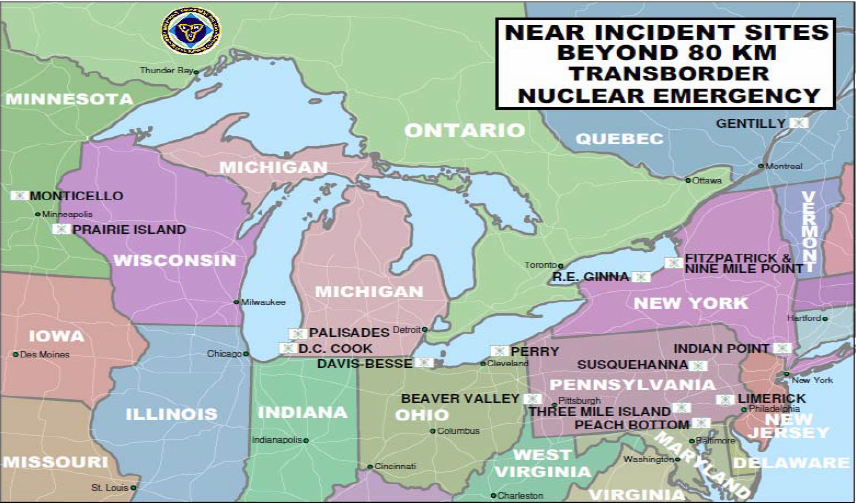Chapter 2 Characteristics of a transborder incident
2.1 The potential hazard
2.1.1 A transborder nuclear incident or event involving the release of radioactive material to the atmosphere
2.1.2 Because of the distances involved, a transborder incident would likely not pose any direct hazard to people through external exposure to radioactivity and therefore would not require exposure control protective measures such as sheltering and/or evacuation.
2.1.3 The main hazard would most likely be the radiological contamination of food and water supplies that could, depending on the levels, pose a hazard to people and animals if ingested. The main concern would be those areas lying within 80 km (50 miles) of the nuclear facility at which an accident occurs.
2.1.4 The pattern of radiological contamination within Ontario resulting from a transborder accident would vary, depending on the distance to the source of the released radioactive material. From an operational perspective, two types of incidents can be identified, as discussed below.
2.2 Near incident
2.2.1 For emergency management purposes, a Near Incident shall be defined as a nuclear accident or event at a site within the states and provinces adjacent to Ontario.
2.2.2 The radioactive emission resulting from a Near Incident could reach Ontario in two modes:
- As a plume. In this case the emission is likely to have a greater impact on areas over which it passes which are closer to its source than those farther away.
- Transported by higher altitude winds and deposited in a dispersed pattern over any part of the province.
2.2.3 Near incident sites
- Annex A, Appendix 1 lists the nuclear installations located within the states and provinces adjacent to Ontario that are within 80 kilometres, which could cause a Near Incident. These sites are shown in Figures 2.1 and 2.2.
- Annex A, Appendix 2 lists the nuclear installations in jurisdictions adjoining Ontario that are beyond 80 km. These sites are shown in Figure 2.3.
2.3 Far incident
2.3.1 For emergency management purposes, a Far Incident shall be defined as a nuclear accident or event anywhere in the world which could affect Ontario, other than a Near Incident.
2.3.2 The radioactive emission resulting from a Far Incident would likely only reach Ontario through transport by upper layer winds. Whether any such radioactive material reaches the province would depend on:
- the nature of the accident (especially the amount of radioactive material released and the energy in the release),
- the distance to the source, and
- meteorological conditions.
2.3.3 If any radioactive material did reach Ontario, it would be deposited fairly evenly over the province, except where precipitation brought down radioactive material in a more concentrated form.
2.4 Protective measures
Ingestion Control Measures may be required to deal with the possible hazard from a transborder nuclear emergency:
- Milk, Food and Water Control
Banning the consumption of milk, food and water that may have been contaminated, and banning their export outside the affected area. - Pasture Control
Removing milk and meat producing animals from pasture and access to open water sources, and supplying them with uncontaminated feed and water. - Produce and Crop Control
Restricting the harvesting or processing of potentially or actually contaminated crops, vegetables and fruits, and banning their export outside the affected area. - Livestock Control
Ordering the quarantine of livestock in the affected area to prevent movement to other areas, and banning slaughter of such animals for food.
2.5 Secondary Zone municipalities
2.5.1 The Secondary Zone is defined as the area within which it is necessary to plan and prepare for taking ingestion control measures, as per section 2.4 above.
2.5.2 In terms of ingestion control protective measures it is likely that, only this Secondary Zone will be considered in a transborder nuclear emergency. The radius of the Secondary Zone shall be 80 km from the nuclear installation.
2.5.3 The municipalities within the Secondary Zone of the Near Incident Sites within 80 kilometres of Ontario are listed in Annex B.
2.6 Emergency organization
2.6.1 Province
- The emergency management organization shall be based on the Incident Management System (the PNERP, Chapter 7) and shall include some of the elements of that organization (see paragraph 3.3.2).
- Liaison Arrangements
- In the event of a Near Incident at a nuclear installation lying within 80 kilometres of Ontario, the PEOC will contact the affected municipality(ies) in Ontario and the affected U.S. State Emergency Operations Centre and discuss the option of deploying liaison teams:
- to the affected Secondary Zone municipalities (Annex B).
- to the jurisdiction in which the incident has taken place.
These teams may be comprised of:
- EMO Field Officers
- Technical Staff
- Emergency Information (EI) Officers
As appropriate to the situation.
- In the event of a Near Incident at a nuclear installation lying within 80 kilometres of Ontario, the PEOC will contact the affected municipality(ies) in Ontario and the affected U.S. State Emergency Operations Centre and discuss the option of deploying liaison teams:
Municipalities
Secondary Zone municipalities should be able to carry out their roles in a transborder nuclear emergency (implementing and/or assisting in the implementation of ingestion control measures (section 2.5)) using their normal organizational structure. Only in exceptional cases would it become necessary for a Secondary Zone municipality to set up a full emergency response organization.
2.7 Arrangements with other jurisdictions
Ontario is developing agreements with adjoining jurisdictions containing Near Incident sites regarding the arrangements for mutual aid assistance in the event of a nuclear emergency originating in one of them (or in Ontario).
These agreements include the following items:
- Notification arrangements.
- Exchange of information.
- Agreement to receive, accommodate and provide facilities to provincial staff deployed to other jurisdictions (paragraph 2.6 above).
- Coordination of Emergency Information.
2.8 International arrangements
2.8.1 Canada and the United States have adopted a Joint Radiological Emergency Response Plan which provides for early notification, coordination of activities, and provision of mutual aid between the two countries in the event of a nuclear emergency that could affect or involve both of them.
2.8.2 Canada is a signatory to various international conventions sponsored by the International Atomic Energy Agency (IAEA). These include those covering international notification of a nuclear accident, and the provision of information and assistance in such a situation.
2.8.3 The Chief , Emergency Management Ontario, will ensure that arrangements are in place so that relevant notifications received by the Government of Canada under paragraphs 2.8.1 and 2.8.2 above, are promptly conveyed to the PEOC.
2.9 Nuclear emergency response in the United States
Annex C outlines the roles of the various jurisdictions and organizations in responding to an accident/event at a nuclear installation in the USA.



Footnotes
- footnote[*] Back to paragraph Release of radioactive material to a lake adjoining Ontario would not pose a hazard because of the massive dilution effect of the lake water. Any risk through contamination of marine life would be dealt with under existing environmental control programs.